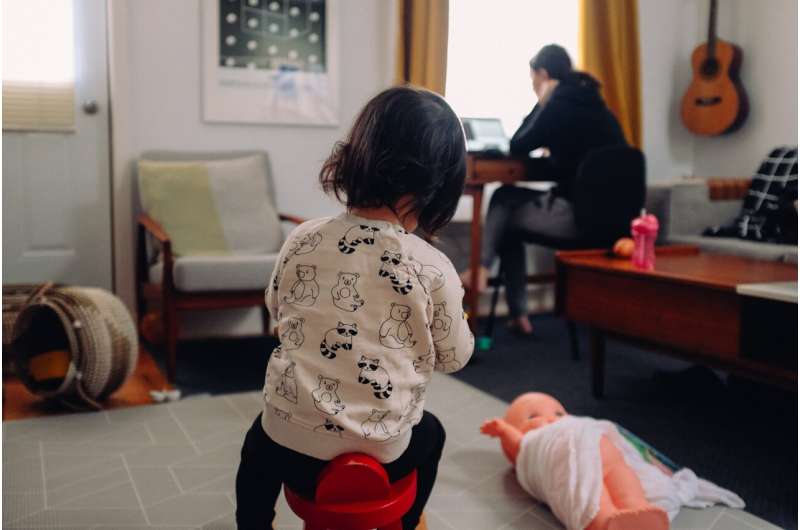This article has been reviewed according to Science X's editorial process and policies. Editors have highlighted the following attributes while ensuring the content's credibility:
fact-checked
trusted source
written by researcher(s)
proofread
The shift to working from home will be difficult to reverse

The onset of the COVID-19 pandemic triggered a sudden disruption of everyday life. While many things are back to the way they were before, one change has proven harder to reverse: working from home.
Three years after the switch to remote work, there is little sign people are growing tired of it. In fact, experiences of working from home have become more positive over time. What's more, our latest research shows that remote work is not eroding people's well-being.
This evidence points to one conclusion: employers should focus more on managing new hybrid work models and less on trying to force employees back into their cubicles.
Who is working from home?
The Survey on Employment and Skills has been tracking the pandemic's impact on the workplace over the past three years.
The latest wave—a survey of 5,904 Canadian adults conducted in March 2023—found that almost two in five (38 percent) people worked remotely at least some of the time in the early months of 2023. These individuals had previously worked outside the home before the pandemic.
The likelihood of working from home varies significantly by occupation. A majority of office workers (57 percent) and executives or managers (57 percent) work from home at least some days.
But working from home is much less common among skilled trade workers (16 percent). The likelihood of working from home is also higher for workers with more education or higher incomes.
These figures remind us that COVID-19's impact on work goes beyond the appeal of remote work. It has also created a new division in the labor force between those whose jobs can be done at home (mostly white-collar workers) and those whose jobs cannot (mostly blue-collar and service workers).
This new division is likely to continue because those who are still working from home like the new arrangement.
People prefer remote work
From the start, a majority of those who switched to remote work said they preferred it to in-person work.
The proportion of people holding this view increased to 74 percent in 2023 from 63 percent in 2020. In addition, over the past three years, seven out of 10 individuals working from home said they wanted their employer to allow them to do so after the pandemic ends.
When people say they would like to work from home, they really mean it. Forty-three percent of those who want to keep working from home say they would like to do so every day; three-quarters (73 percent) say at least two to three days a week. Only one in four envision working from home occasionally.
Another indicator of how hard it will be to reverse this trend is that a small, but noticeable, group of workers have reorganized their lives around working from home.
About one in ten said they switched jobs to make it easier to work from home. The same proportion said the option to work from home allowed them to relocate to a different community. Given the life choices some have made, getting them back into the office will take more than a memo from their managers.
Health and well-being findings
The biggest obstacle to getting everyone back into the workplace is the fact that people who are working from home seem to be doing better—or at least no worse—than those who are not.
At the start of the pandemic, there were concerns that adjusting to working from home, like finding a suitable workspace and dealing with distractions, would negatively impact people's mental well-being.
But three years later, those who work from home are reporting slightly higher job satisfaction, mental health and overall well-being than their counterparts who are working outside the home.
They also appear to have a similar number of connections to friends, suggesting they do not feel more isolated.
Since there are specific demographics of workers that are more likely to work remotely, our analysis controlled for things such as education and occupation.
The results confirmed that people who are working from home are genuinely more satisfied and healthy than those who are not. At the very least, they are not more likely to report feeling lonely or isolated. These positive outcomes were most noticeable for women and for younger workers.
New workplace challenges
Our survey not only provides insights about the current remote work situation, but also sheds light about what it was like to go into the workplace every day prior to the pandemic.
For many workers, it would seem the pre-pandemic arrangement was inconvenient, tiring or stressful. People worked in-person jobs because no other option was on offer. The pandemic forced an alternative out into the open, and what began as a temporary disruption has become permanent.
Employers now face the challenge of not only accommodating ongoing remote work arrangements, but also managing new inequities between those whose jobs lend themselves to remote work and those whose don't.
Employers also need to think more about the job satisfaction and mental health—not just of remote workers, but of those who can't work remotely and find themselves in a workplace that feels a lot more empty than before.
Provided by The Conversation
This article is republished from The Conversation under a Creative Commons license. Read the original article.![]()




















